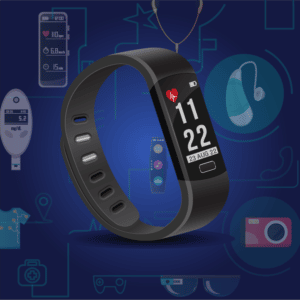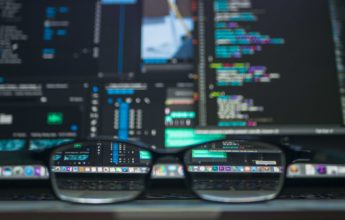Mobile app development is not only here to stay, it has become a critical element of how most of us interact with our phones, and beyond. But now wearable apps and devices are taking that interaction another step further. This new technological frontier offers tons of exciting new possibilities for wearable app development. While the health and fitness industries have a head start when it comes to wearables, many industries have taken notice of the benefits.
Now, smartwatches, belts, clothing, eyewear, and even implantables are beginning to saturate the market. Indeed, the wearable technology market is predicted to reach $380.5 billion by 2028.
With so much potential in the wearable technology market, the challenge for developers of wearable apps is to stay ahead of the trends, and deliver the best experience possible. With that in mind, let’s take a look at nine of the key trends that are driving wearable app innovation today.
IoT Integration Goes Mainstream
The Internet of Things, or IoT, is fundamental to interconnected devices like wearables. The IoT is what connects devices and allows for the free flowing exchange of data we use for smart living. But IoT does much more than connect wearable devices. From oil companies to retail and transportation, IoT is slowly permeating industries of all kinds.
This mainstreaming of the integration of IoT devices offers an incredible range of opportunities for wearable apps – especially when it comes to healthcare. Some recently released healthcare IoT devices include:
- Wearable glucose trackers.
- Remote asthma monitors.
- Bluetooth equipped tracking apps for cancer patients.
- Wearable defibrillators.
Fitness tracking and home automation are also areas seeing an explosion of IoT devices. Tech giants like Apple, Google, and Amazon have weighed in with smartwatches and -speakers.
In order to capitalize on these opportunities, developers of wearable apps need to integrate IoT into their products.
Sensor Technology Improvements
Wearable apps rely on sensor technology for a variety of tasks. From allowing certain functionalities, to aiding in data collection and personalization, sensor technology is a critical aspect of wearable devices. Once again, the healthcare industry is a great place to look for examples of this. Today, sensor technology is used in heartbeat monitors, blood pressure measurements, and even calorie counting. Similarly, fitness wearables use sensors to track users’ pulse and how many steps they take in a day.
As this technology continues to improve, developers will be able to use them, and the data they gather, to improve user engagement and enhance their app’s user interface and experience.
GPS Gets a Boost
GPS and other location-based services have become a critical element of wearable apps and devices. Devices like smartwatches and fitness trackers already collect and utilize location data. Additionally, as GPS improves, more and more industries have incorporated the technology. One example is courier and logistical services. Now when you order dinner through a delivery app you can track its path to you in real time.
Another exciting example of where GPS and wearable apps are heading is retail. As GPS technology improves and is integrated into more wearable devices, expect retailers to attract customers by implementing location-based marketing techniques.
Introduction of Beacon Tech
While we’re on the topic of location-based technology, beacon technology has helped improve the user experience of many wearable apps. Basically, beacons are low-cost, low-energy Bluetooth transmitters. These tiny gadgets broadcast signals to nearby devices. Beacons offer the advantage of effective and easy connectivity with electronic devices close in proximity. Through this connection they can share information and aid in location-based searching.
While this technology is already widely used in smartwatches, the number of devices utilizing it is expanding. That’s because beacons provide more robust and precise location data when compared to GPS. As a result, mobile app development companies would be wise to emphasize the use of beacon technology in their wearable apps.
Artificial Intelligence
Artificial Intelligence, or AI, has made a name for itself across app development and corporate industries in recent years. By aiding in automation, interactivity, and personalization, AI has changed the way users interact with their devices, conduct business, and even go about their lives.
Now, AI has the potential to offer this kind of fast-paced, automated, and personalized solutions to wearable apps. Through the elimination of errors and bugs, and by providing time-efficient and effective services, AI will continue to improve the quality of wearable apps.
Customized Functions
When compared to smartphone apps, wearable apps need far fewer resources. It’s not difficult to understand why; smartphones have powerful hardware and lots of memory. This means smartphone apps can have a lot of bells and whistles – in other words, extra functionality. However, since a wearable app must rely on far less memory and processing power, it must be restricted to its core purpose.
For this reason, customized app functions will give users more freedom, while allowing developers to stay laser focused.
Incorporating Contactless Payment
Another opportunity wearable app developers have is the incorporation of contactless payment. With the growing use of Google Wallet and Apple Pay, wearable apps can provide a new way to make online payments.
The incorporation of contactless payment methods into wearable apps could have a major impact on a variety of industries, especially mobile- and eCommerce, and banking. Indeed, the global contactless payment market is expected to reach nearly $18 billion by 2025.
Powerful Data Collection
It’s no secret that wearable technology has made it easy to collect the most relevant data regarding users’ shopping experience and overall customer behavior. Now, wearable apps have the power to target specific audiences and gather pertinent data quickly. Application development companies can then use this data to provide a more customized or personalized experience.
As wearables like fitness trackers, smart eyewear, and other body-mounted gear become more and more prominent, they will generate mountains of useful data. With more to analyze and learn from, data collection and usage will become more robust and more refined. This in turn will create new opportunities for both developers and businesses.
Data Security
With all this data, security concerns are sure to follow. In fact, users are far less likely to trust a company twice if the handling of their data even looks suspicious the first time. So, as the threat of cyber attacks and data breaches grows, wearable app developers need to implement – and continuously improve – data security measures. This reassures users while providing an extra layer of protection for your business interests.
The Future of Wearable Apps
These are just some of the most popular trends we expect to see in the world of wearable application development. The potential of wearable apps and devices is undeniable. As the technology matures and grows into new industries more trends and opportunities are sure to arise. But knowledgeable and experienced wearable app developers are ready to handle the challenges with creative and unique solutions.







